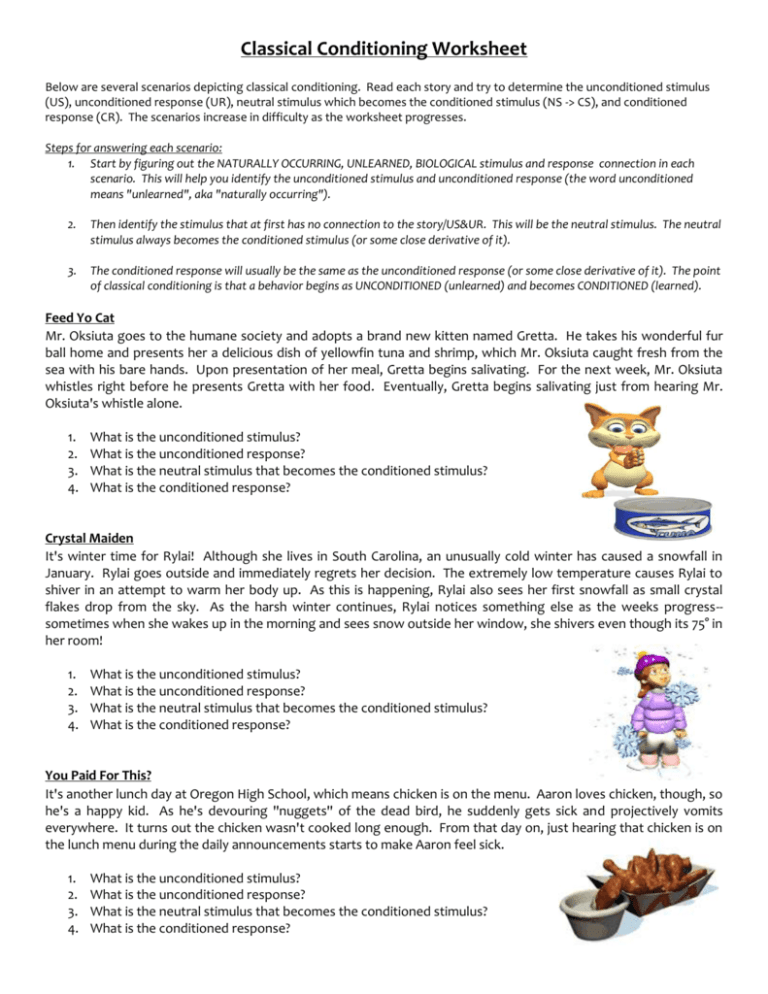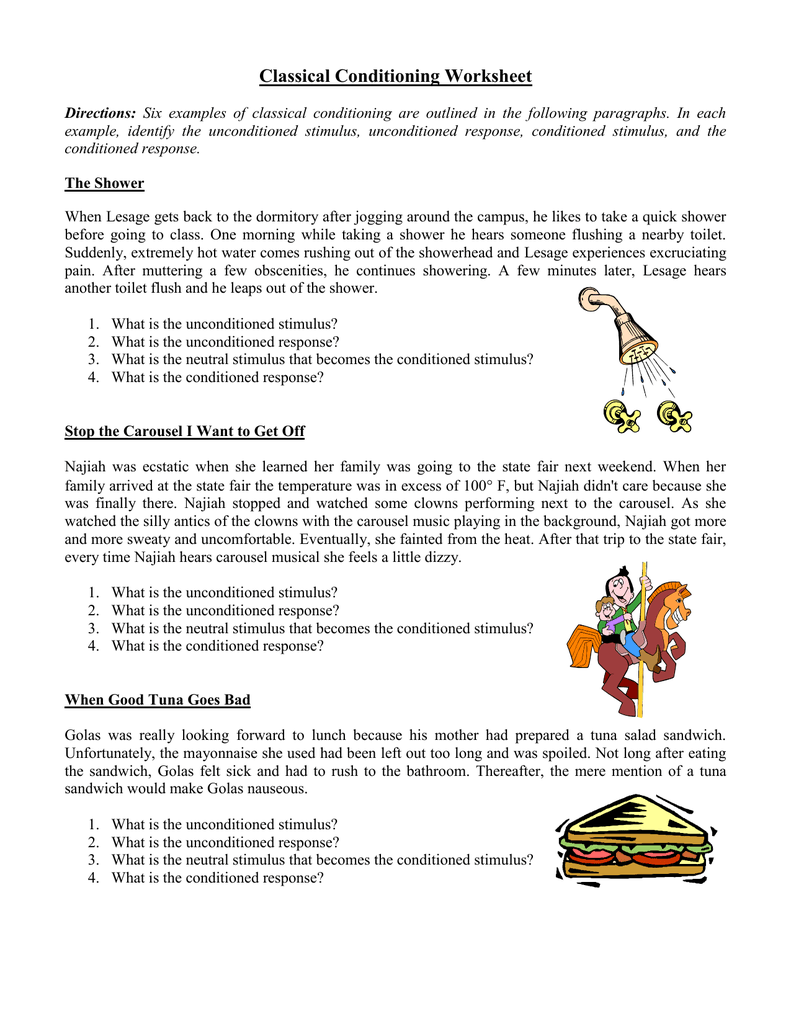Describe an Activity Using Classical Conditioning
Classical conditioning can play different roles in the classroom. In classical conditioning the conditioning process in which the experimenter learns to associate two stimuli on the basis of the involuntary responses that occur before him.

Classical Conditioning Worksheet
Classical conditioning exercises in the classroom help reinforce lessons presented about both conditioned and unconditioned stimuli and their effects on learned behaviors.

. The theory was first discovered by the Russian physiologist Ivan Pavlov in early 1900 when he was experimenting on his dog Circa. This lesson plan uses two short videos as well as hands-on activities. Classical conditioning was discovered by Ivan Pavlov a Russian physiologist who conducted a series of classic experiments with dogs.
In marketing classical conditioning can be used to promote aggressive learning that helps customers associate certain behaviours or feelings with brands or products. Classical conditioning is the pairing of a neutral stimulus bell with an unconditioned response salivation. Transition notifications such as a bell gong chimes music or a clap may sometimes be used.
Classical conditioning is the learning of involuntary responses by pairing a stimulus that normally causes a particular response with a new neutral stimulus after enough parings the new stimulus will also cause the response to occur. After the association is learned the previously neutral stimulus is sufficient to produce the behavior. Classical conditioning refers to learning that occurs when a neutral stimulus eg a tone becomes associated with a stimulus eg food that naturally produces a behavior.
The process then leads to the response of fear towards the previously neutral stimulus. Classical conditioning is a form of learning that deals with acquiring new information or behavior via the process of association. In brief classical conditioning means that a specific stimulus causes specific responses.
Throughout the course of his researching career Pavlov was investigating the automatic reflexes of animals when he made his discovery of the classical conditioning principle. Attention-getters such as turning off the lights rhyming student callbacks hand signals a bell. In classical conditioning a neutral stimulus is presented immediately before an unconditioned stimulus.
You hear that tone and instinctively reach for your smartphone only to. To make their products more lucrative most of the companies use the brand value of celebrities in their advertisements. Neutral conditioned and unconditioned stimuli and responses Our mission is to provide a free world-class education to anyone anywhere.
Classical conditioning is the process by which a naturally occurring stimulus is paired with a stimulus in the environment and as a result the environmental stimulus eventually elicits the same response as the natural stimulus. Once these associations are made we respond reflexively. After several pairings the neutral stimulus becomes the conditioned stimulus which will cause the conditioned response salivation.
By definition classical conditioning is the pairing of an unconditioned stimulus with a conditioned stimulus to produce a conditioned response Levin 1995 p175. Pavlov would sound a tone like ringing a bell and then give the dogs the meat powder The tone was the neutral stimulus NS which is a stimulus that does not naturally elicit a responsePrior to conditioning the dogs did not salivate when they just heard the tone because. The first part of the classical conditioning process requires a naturally occurring stimulus that will automatically elicit a response.
Classical conditioning is defined as learning that takes place when an originally neutral stimulus one that doesnt elicit any particular reflex comes to produce a conditioned response. Classical conditioning is a form of behaviorism in which a specific stimulus produces a predictable response as in Pavlovs dog experiments. Classical conditioning doesnt only work on dogs and cats.
The art of advertising can be considered as a classic case of classical conditioning. How to Apply Classical Conditioning in the Classroom Attention-getters. 10 Classical Conditioning Examples in Everyday Life.
Classical conditioning is a special type of associative learning that requires using an unconditioned stimulus see below. Pavlov had identified a fundamental associative learning process called classical conditioning. Companies make commercial advertisements to attract consumers.
On the contrary in operant conditioning the behavior of the organism will be modified depending on the consequences that occur later. Conditioned Buzzer Response The conditioned buzzer responses is an exercise that demonstrates how quickly a group can be conditioned to perform a specific activity. Human behavior is influenced quite a bit through classical conditioning processes.
Smartphone Tones and Vibes. Lets explore 10 of them. Pavlovs experimental works led him to discover classical conditioning and its laws which he demonstrated using his famous Pavlovs dog experiment.
When a neutral stimulus something that does not cause fear is associated with an unconditioned stimulus something that causes fear. Classical conditioning involves forming an association between two stimuli resulting in a learned response. Classical conditioning was the discovery of a Russian physiologist by the name of Ivan Pavlov.
This unconditioned stimulus naturally and automatically triggers salivating as a response to the food which is known as the unconditioned response. Classical conditioning is an essential element of any psychology curriculum. If youve ever been in a public area and heard a familiar notification chime this classical conditioning example will certainly ring true for you.
The classical conditioning process involves pairing a previously neutral stimulus such as the sound of a bell with an unconditioned stimulus the taste of food. Fear is a behavior that can be learned via classical conditioning. There are three basic phases of this process.
Classical conditioning involves learning a new behaviour after developing a certain association with the. Behaviorism is a school of psychology that views all behaviors as learned. Khan Academy is a 501c3 nonprofit organization.
8 1 Learning By Association Classical Conditioning Introduction To Psychology 1st Canadian Edition

Classical Conditioning Worksheet

Classical Conditioning How It Works And How It Can Be Applied
No comments for "Describe an Activity Using Classical Conditioning"
Post a Comment